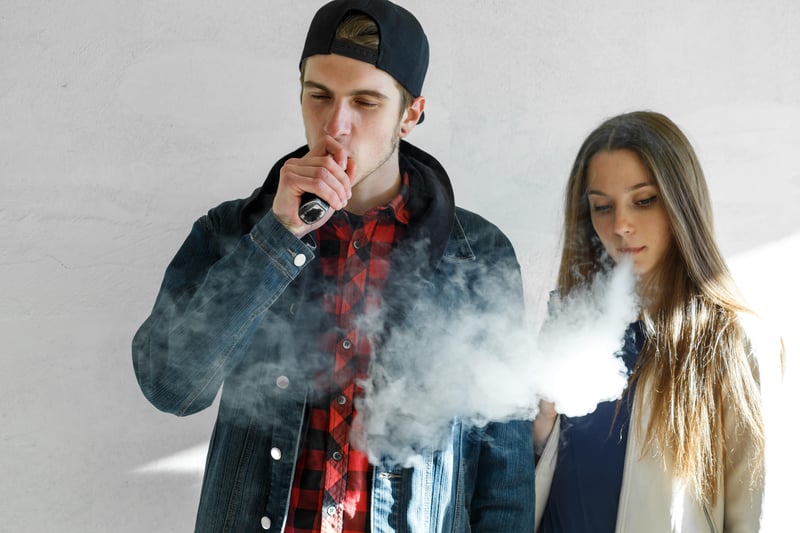Manténgase sano!

- Cara Murez
- Posted May 18, 2023
Vaping Could Up Teens' Odds for Marijuana Use, Binge Drinking
Teens who use electronic cigarettes are significantly more likely than non-vapers to binge-drink and use cannabis, new research finds.
Surveys of teens ages 13 to 18 revealed that vapers were 20 times more likely to use marijuana than teens who used no nicotine products. And those who vaped in the previous month were six times more likely to have had multiple binge-drinking episodes in the previous two weeks.
These associations were even stronger for kids who smoked traditional cigarettes and vaped.
"The surprising thing is just how strong those links were,"said lead study author Noah Kreski, a data analyst for Columbia University Mailman School of Public Health. "The associations we see there are just far and away so much higher than what we usually see in a study on really anything."
The long-term impacts of vaping on health aren't fully known, Kreski noted, but unfavorable evidence is mounting.
Because of this strong overlap, effective interventions should simultaneously address vaping, drinking and cannabis use, Kreski said.
Researchers used the Monitoring the Future survey from the U.S. National Institute on Drug Abuse to track trends of substance use in more than 51,000 youths in grades 8, 10 and 12 (ages 13 to 18). Students were surveyed between 2017 and 2019.
The authors focused on past 30-day nicotine use, including non-smoking, cigarette smoking only, vaping only and combined smoking and vaping.
Compared to youths who used no nicotine, those who smoked cigarettes in the past 30 days were eight times more likely to use cannabis. Those who vaped were 20 times more likely to use cannabis. And those who smoked cigarettes and vaped were especially at risk -- 40 times more likely to use cannabis.
The link between past 30-day nicotine use and two-week binge drinking was especially strong for those who used traditional cigarettes and e-cigarettes. They were about six times more likely to have binged once during the previous two weeks. They were almost 22 times more likely to have binged on three to five occasions.
"These patterns are so strong in terms of where there is some substance use, there's very likely other substance use,"Kreski said.
What the authors can't tell from the study is whether vaping makes a teen want to use other substances or whether they're using a variety of substances and have included vaping in the mix.
There also may be a strong social aspect to vaping, Kreski said. Teens could be using a friend's vaping device, for example.
"This confirms what we've long known about the linkage of the use of different substances,"said Dr. Marc Fishman, medical director of Maryland Treatment Centers and an associate professor of psychiatry at Johns Hopkins University School of Medicine.
Fishman, who was not involved in this study, emphasized two key messages from the study: Vaping is a prevalent and important issue, and that the combination of vaping and smoking correlated with the highest severity of other substance use markers.
Noting the findings are "worrisome," Fishman said vaping is also upending progress in keeping kids off nicotine.
Many factors may explain why use of one substance would increase the odds of using another, Fishman said. These could include a biological reason and access to more than one substance in certain circumstances.
"The most important thing is not to pretend it's no big deal,"Fishman said.
It's important to not just chalk it up to adolescent mischief. Yes, teenagers will get into trouble, but it's also important to make this health messaging front and center, he said.
"Parents need to talk to their teens. Pediatricians need to bring these things up. Visits need to have clear messaging that we want to delay onset of substance use from nicotine to alcohol to cannabis and to others until after age 21, that the right amount of intoxicants for teenagers to be using is zero,"Fishman said.
Kreski said he hopes the takeaway for parents isn't to judge or punish their adolescents, but to check in with them and open a dialogue about making healthy choices.
"We really want to emphasize these results as an opportunity to communicate and support and understand, which I think is always so important, especially at such a vulnerable age,"Kreski said.
For public health officials and doctors, it may be important to look at these issues and their broader patterns, Kreski added.
Study findings were published May 17 in the journal Substance Use and Misuse.
More information
The U.S. Centers for Disease Control and Prevention has more on e-cigarettes and teens.
SOURCES: Noah Kreski, MPH, data analyst, Columbia University Mailman School of Public Health, New York City; Marc Fishman, MD, DFASAM, medical director, Maryland Treatment Centers and associate professor of psychiatry, Johns Hopkins University School of Medicine, Baltimore; Substance Use and Misuse, May 17, 2023
